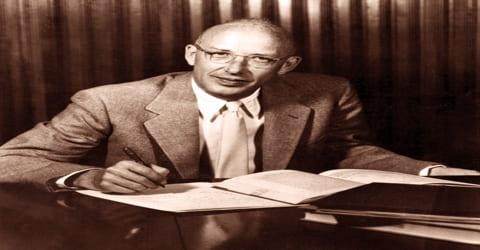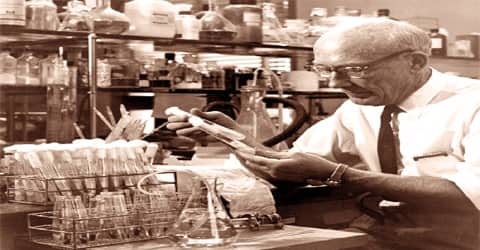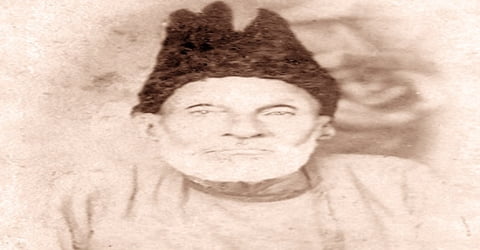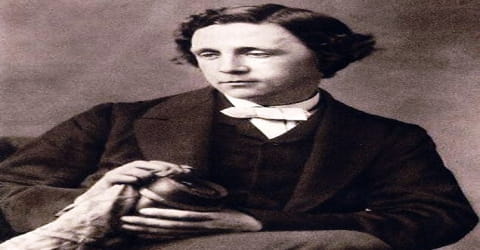Biography of Edward L. Tatum
Edward L. Tatum – American geneticist.
Name: Edward Lawrie Tatum
Date of Birth: December 14, 1909
Place of Birth: Boulder, Colorado, United States
Date of Death: November 5, 1975 (aged 65)
Place of Death: New York City, New York, United States
Occupation: Geneticists
Father: Arthur Lawrie Tatum
Mother: Mabel Webb Tatum
Spouse/Ex: June Alton (m. 1934), Viola Kanter (m. 1956), Elsie Bergland (m. 1974)
Children: Margaret and Barbara
Early Life

An American biochemist who helped demonstrate that genes determine the structure of particular enzymes or otherwise act by regulating specific chemical processes in living things, Edward L. Tatum was born on December 14, 1909, in Boulder, Colorado, the U.S. the son of Arthur Lawrie Tatum, a pharmacologist, and Mabel Webb Tatum. He shared half of the Nobel Prize in Physiology or Medicine in 1958 with George Beadle for showing that genes control individual steps in metabolism. The other half of that year’s award went to Joshua Lederberg.
Tatum was a seminal figure in the development of physiological genetics, made fundamental contributions to understanding biochemical processes and their relation to gene action, and was a pioneer in the use of microorganisms as genetic models. He also was one of the first to experimentally demonstrate the importance of “sex” in bacteria.
Born in Colorado, initially, Tatum followed his father’s footsteps to study chemistry at the graduation level; then took up microbiology for his postgraduate degree and biochemistry for his Ph.D. His hybrid educational qualifications later affected his career. Nonetheless, his talent was recognized by his professors, who recommended him to Professor Beadle, while he was working on Drosophila at the University of Stanford. Afterwards, the two scientists worked on Neurospora and established the ‘one gene-one enzyme’ theory, which earned them their Nobel Prize. Meanwhile, Tatum had to leave Stanford because he was an Assistant Professor in the Biology department with a degree in chemistry. Subsequently, he shifted to the University of Yale as Assistant Professor in Botany and began working on bacteria with another Nobel winning scientists Joshua Lederberg, whom he had also mentored. Subsequently, they established that E-coli bacteria entered a sexual phase, during which it could pass on genetic information. At last, the University of Stanford invited him back as a full professor at the Department of Biology. Later, he held many important positions and served in different capacities until his death.
Childhood, Family and Educational Life

Edward L. Tatum, in full Edward Lawrie Tatum, was born on 14th December 1909, at Boulder, Colorado, the U.S. At the time of his birth, his father, Arthur Lawrie Tatum, was an instructor in chemistry at the University of Colorado. Later he earned his degrees and became a Professor of Pharmacology. Edward’s mother, Mabel Webb Tatum, died while he was a child. His father later married Carla Harriman. Edward was the first surviving son of his parents. His twin, Elwood, died soon after the birth. He had two younger siblings; a brother named Howard J. Tatum and a sister named Besse C Tatum.
For the greater part of his life, Arthur held different teaching positions in different universities in the Midwest. Therefore, while Edward was growing up, the family was moving from place to place. However, they always had a scientific environment at home, which helped grow his aptitude towards science. From 1918 to 1928, Arthur was engaged at the University of Chicago. During this period, Edward studied at the University of Chicago Laboratory School and graduated from there in and around 1926. Afterward, Edward enrolled at the University of Chicago. But when after two years, his father moved to the University of Wisconsin Medical School as Professor of Pharmacology Edward shifted with him.
Tatum attended the University of Chicago for two years, then transferred to the University of Wisconsin, receiving his BA in chemistry in 1931, MS in microbiology in 1932, and Ph.D. in biochemistry in 1934. For his doctoral thesis, he chose to work on the nutrition and metabolism of bacteria. Tatum soon established that microorganisms needed thiamine, also known as Vitamin B1, to grow. The thesis, which earned him his Ph.D., also laid the ground for his future work, which he undertook with G. W. Beadles.
Personal Life
Edward Lawrie Tatum first married June Alton on 28th June 1934. The couple had two daughters, Margaret and Barbara. They divorced sometime in 1956.
On 16th December 1956, Tatum married Viola Kanter. They remained married until her death on 21st April 1974. Later that year, he tied the knot for the third time and married Elsie Bergland. They remained married until his death shortly after.
Career and Works

Edward Lawrie Tatum stayed at Wisconsin from 1934 to 1937, though visiting during 1935 at the University of Utrecht in Holland. At Utrecht, he worked with Fritz Kögl, who had himself recognized the importance of biotin, and with Nils Fries. Tatum worked on identifying growth factors in staphylocci, though he was apparently unsatisfied with the results.
As a research associate at Stanford University (1937-41), Tatum collaborated with Beadle in an attempt to confirm the following concepts: all biochemical processes in all organisms are ultimately controlled by genes; all these processes are resolvable into a series of individual sequential chemical reactions (pathways); each reaction is in some way controlled by a single gene; and the mutation of a single gene results only in an alteration in the ability of the cell to carry out a single chemical reaction.
Tatum also got an offer to work on the microbiology of butter. Although his father wanted him to take that up, Tatum joined Beadle’s team at the Department of Biological Sciences at the University of Stanford as Research Associate without teaching responsibility, in 1937. He first concentrated on extracting pigments precursors from the larvae of Drosophila. By 1941, he was successful in isolating the V+ hormone in a crystalline state from bacterial culture and identified it as kynurenine. Unfortunately, Adolf Butenand, who was working on this independently, preceded him in this discovery and so Tatum received no credit for his work. Jarred by this experience he and Beadle decided to look for another model and chose Neurospora crassa.
Tatum went on to study genetics in bacteria. An active area of research in his laboratory was to understand the basis of Tryptophan biosynthesis in Escherichia coli. Later, Tatum and his student Joshua Lederberg showed that E. coli could share genetic information through recombination.
Tatum knew from previous work that biotin (another B vitamin) was required if Neurospora was to be cultivated on inorganic media. They set about to investigate its nutritional requirements, recognizing that genes must control the biosynthetic processes in nutrition and, furthermore, that these processes would exhibit considerable complexity at the genetic or physiological level. Their plan was to reveal the underlying genetic complexity by investigating the nutritional requirements of mutant strains.
By February 1941, Tatum and Beadle began exposing Neurospora to X-ray in order to obtain mutants that would have biochemical defects because of nutritional deficiency. Ultimately, it was the mutant number 299, which was the first identifiable mutant that required pyridoxine for normal synthesis. Subsequently, they obtained hundred of mutants which were deficient in nutrition and began working on them. By May 1941, they were ready to submit their first report, in which they concluded that “the gene and enzyme specificities are of the same order”. Later in the same year, they proposed a direct link between gene and enzymes, which led to the establishment of ‘one gene-one enzyme’ hypothesis. Although the theory has been refined by later scientists, it remains the same in essence.
Overall, Beadle and Tatum developed a methodology for exploring the impact of genes on the physiology of cells and promoted the one gene-one enzyme theory committed to the idea that chromosomal genes control the synthesis of proteins and thereby influence development. Along with the establishment of Neurospora as a model organism within genetics, they more generally promoted the place of bacteria in genetic research.
In the winter of 1941, Tatum was promoted to the post of Assistant Professor. He then volunteered to develop and teach biochemistry course to both biology and chemistry students. However, because he was a chemistry graduate working in the biology department, his position became more and more shaky. Tatum left the University of Stanford in 1945 to join the University of Washington at St. Louise. But after a semester he shifted to the University of Yale as Assistant Professor of Botany. Here he developed a biochemically oriented microbiological course at the Department of Botany. Later, he became Professor of Microbiology in the same institute.
As a professor at Yale University (1945-48), Tatum successfully applied his methods of inducing mutations and studying biochemical processes in Neurospora to bacteria. With Lederberg, he discovered the occurrence of genetic recombination, or “sex,” between Escherichia coli bacteria of the K-12 strain. Largely because of their efforts, bacteria became the primary source of information concerning the genetic control of biochemical processes in the cell.
In 1948, Tatum returned to the University of Stanford as a full Professor in the Department of Biology. Here, he mostly pursued and supervised different biochemical projects. Later, when the School of Medicine was being reconstructed at the University premises Tatum helped to develop its curriculum. In 1956, he has appointed the head of the newly formed Department of Biochemistry. During this time the Institution became a major center of scholarship. However, for the personal reason, he left Stanford to join Rockefeller Institute towards the end of the year. For personal reasons, with the dissolution of his marriage, he found it desirable to leave Stanford, moving to the Rockefeller Institute and marrying Viola Kanter in New York City on 16th December 1956.
At the Rockefeller Institute, Tatum again found himself occupied with institutional affairs. He devoted a significant amount of time to national science policy, encouraging fellowship support for young scientists. He also served as chairman of the board for the Cold Spring Harbor Biological Laboratory. In terms of research, he continued to work on Neurospora, studying the effects of various changes on their morphology.
Towards the end of his career, Tatum devoted a considerable amount of time on national science policy and worked hard to strengthen fellowship programs. For some time, he also served as the Chairman of the Board at the Cold Spring Harbor Biological Laboratory.
Awards and Honor
In 1958, Edward Lawrie Tatum and George Wells Beadle received Nobel Prize for Physiology or Medicine “for their discovery that genes act by regulating definite chemical events”. Incidentally, the prize was co-shared by Joshua Lederberg, whom Edward had mentored at the University of Yale while they were working on the recombination of bacteria.
Tatum also received election to the National Academy of Sciences (1952), the Remsen Award from the American Chemical Society (1953), the presidency of the Harvey Society (1964-1965), and numerous honorary degrees.
Death and Legacy
Edward Lawrie Tatum was a heavy smoker and suffered from chronic emphysema. Tatum died on 7 November 1975, from heart failure, at the age of 65.
Tatum is best remembered for his work with George W. Beadle on Neurospora. After observing innumerable mutants over a long period, they came to the conclusion that “A single gene may be considered to be concerned with the primary control of a specific chemical reaction”. Their theory, later dubbed as ‘one gene-one enzyme hypothesis’, helped create the field of molecular genetics. Tatum is also remembered for his work on bacteria at the University of Yale. It was largely because of his work, that bacteria began to be considered as the main source of information for gaining insight into how the biochemical process is controlled by genetics.
Information Source:
















